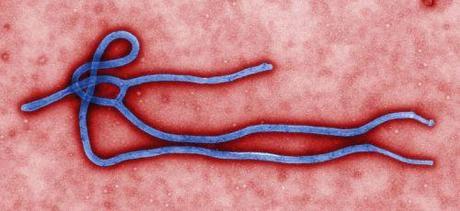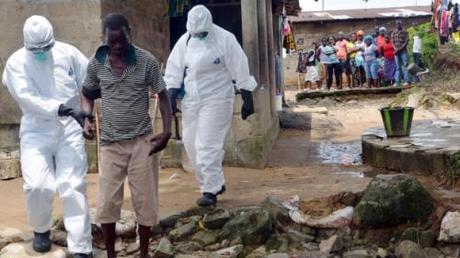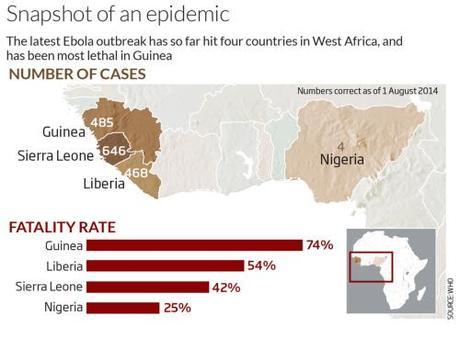
Months ago in April 2014, when Ebola made the jump from the jungles of West Africa to its urban centers, the charity medical group Doctors Without Borders already declared the epidemic to be out of control. That declaration was later repeated by the UN’s World Health Organization and the U.S. Centers for Disease Control and Prevention (CDC).
By now, after taking the lives of more than 1,400 people, this horrific epidemic has gotten even worse. The latest report is that dogs in one community in Liberia are eating the corpses of Ebola victims buried in shallow graves. Being asymptomatic carriers of the virus, this means the dogs can further spread Ebola to humans via bites and scratches.
Note: Liberia was colonized and founded by U.S. freed slaves in 1847.

E. J. Nathaniel Daygbor reports for Monrovia’s The New Dawn, Aug. 26, 2014, that residents of the Johnsonville Township outside Monrovia saw dogs eating the remains of dead Ebola victims who had been buried by the Liberian Ministry of Health and Social Welfare some weeks ago.
The burial was done in a hurry at night following a standoff in the day between residents and the Ministry of Health burial team. The former had refused to grant the authority a piece of land to carry out the burial. The dogs were seen pulling the bodies out of their shallow graves and hastily eating them.
A resident named Alfred Wiah told the NewDawn that upon discovery of the dogs’ behavior, residents immediately contacted the Health Ministry, but to no avail. The residents also attempted to kill all of the dogs, but some escaped.
According to CBS Atlanta/AP, Dr. Stephen Korsman of the University of Cape Town’s medical virology division tells News 24 that dogs can be infected with the Ebola virus but that “infections appear to be asymptomatic. This means that dogs won’t get sick, but they still could carry a potential risk [to humans] through licking or biting.”
The Atlanta-based CDC has sent nearly 70 scientists and staff to help in Liberia, Sierra Leone, Guinea, and Nigeria.

The Ebola epidemic is not just reeking havoc on the populations of West Africa but also on front line health workers and doctors fighting the disease. To date, more than 240 health care workers have developed the disease in West Africa, more than 120 of whom have died.
The CDC continues to insist the Ebola virus is transmitted only via bodily contact. That is why the high incidence of health care workers stricken with Ebola is worrisome because, being knowledgeable about the virus, they would be extra careful by donning protective biohazard body suits like the ones in the pic above.
All of which brings to mind a Canadian research in 2012 which strongly suggests Ebola may spread between animal species, through the air.
The Canadian researchers (from the National Centre for Foreign Animal Disease, the University of Manitoba, and the Public Health Agency of Canada) first inoculated a number of piglets with the Zaire strain of the Ebola virus, which is the deadliest strain with mortality rates up to 90%. The piglets were then placed in a room with four cynomolgus macaques, a species of monkey commonly used in laboratories. The piglets and monkeys were separated by wire cages to prevent direct contact between the species.
Within a few days, the inoculated piglets showed clinical signs of infection indicative of Ebola infection. (Happily, 9 days after infection, all piglets appeared to have recovered from the disease.) Within eight days of exposure, two of the four monkeys showed signs of Ebola infection although they had had no bodily contact with the piglets. Four days later, the remaining two monkeys were sick too.
While the study provided evidence that transmission of Ebola between species is possible, researchers still cannot say for certain how that transmission actually occurred. There are three likely candidates for the route of transmission:
- Airborne
- Droplet
- Fomites: Inanimate objects that can transmit disease if they are contaminated with infectious agents. In this study, a monkey’s cage could have been contaminated when workers were cleaning a nearby pig cage. If the monkey touched the contaminated cage surface and then its mouth or eyes, it could have been infected. -
Meanwhile, writing in Foreign Policy, Pulitzer Prize-winning science writer Laurie Garrett warns Americans and the world that “you are not nearly scared enough about Ebola.” Garrett writes that “experimental drugs and airport screenings will do nothing to stop this plague” and that if Ebola hits Lagos, the capital of Nigeria — Africa’s most populous country — with a population of 22 million, “we’re in real trouble.”
In a Council on Foreign Relations conference call, Garrett said “We’re now in a perfect storm” and that the United Nations World Health Organization is “bankrupt” and drowning in debt. “There is no strategic plan for how this epidemic will be brought under control.”
WND reports that the same term, “perfect storm,” was also used to describe the Ebola outbreak Thursday by CDC director Dr. Tom Frieden, in testimony before Congress on August 7, 2014.
Frieden testified that the CDC raised its emergency operations center to Level 1, the highest possible alert in an effort to better coordinate a CDC-organized surge of health professionals and equipment being rushed to West Africa in an effort to contain the Ebola outbreak.
Frieden also told Congress that it’s “inevitable” that someone with Ebola will get on a plane and fly to the United States, risking an outbreak here.
An outbreak on U.S. soil would require sweeping measures, including total quarantine of cities or sections of infected cities, as well as restrictions on air travel. On the official CDC website are “Specific Laws and Regulations Governing the Control of Communicable Diseases” specifying that, due to Ebola’s incubation period of as long as 21 days, seemingly healthy citizens who show no symptoms of Ebola can be forcibly quarantined at the behest of medical authorities.
Adding to our unease is the fact that U.S. researchers and the military have been studying the use of Ebola as a bio-weapon. Michael Snyder reports that:
- Researchers from Tulane University have been active for several years in the very same areas where this Ebola outbreak began. One of the stated purposes of their research was to study “the future use of fever-viruses as bioweapons”. According to Sierra Leone’s Ministry of Health and Sanitation, Tulane University researchers have been asked “to stop Ebola testing during the current Ebola outbreak,” whatever that means.
- The Navy Times says that the U.S. military has been interested in studying Ebola “as a potential biological weapon” since the 1970s, mainly because Ebola has high mortality rates of 60-90%, and its stable nature in aerosol makes it attractive as a potential biological weapon.
Meanwhile, two dozen suspected Ebola cases have emerged hundreds of miles from West Africa in what health officials are calling a second “unrelated” outbreak in the Democratic Republic of Congo.
See also:
- Deadly Ebola virus jumps from Africa’s jungles to urban centers
- Can out-of-control Ebola epidemic hit America?
~Eowyn

